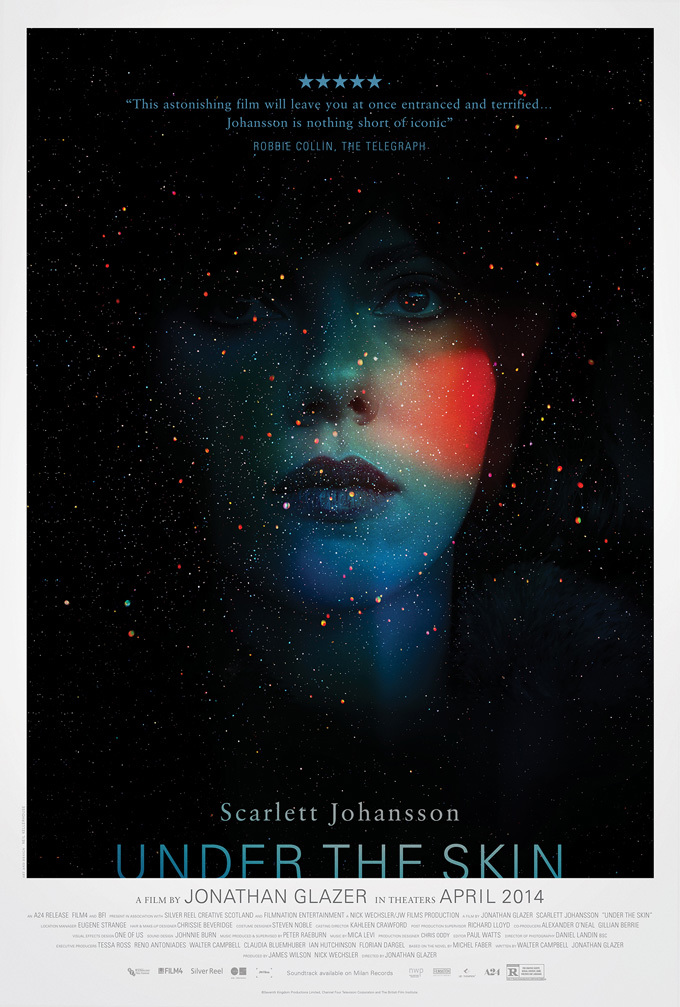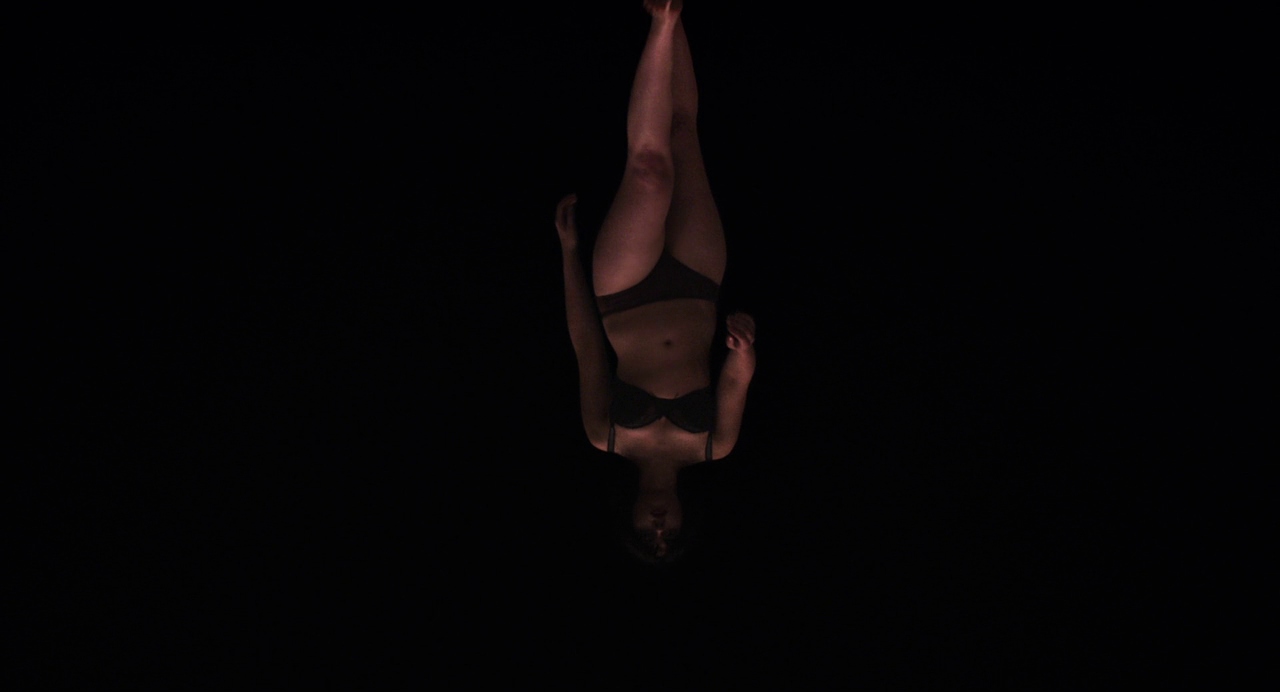

“Where are you from?”
Having sat with Jonathan Glazer’s Under the Skin for a while now, I remain uncertain how I feel about it. I won’t squabble with those who claim that it is plodding and pretentious and willfully inscrutable, but I’ll tentatively go to bat for its off-kilter approach to the sci-fi genre and the awesome terror it evokes in its most sublime sequences. Its polarizing reception seems less due to its arthouse tendencies than the fact that it attracted a mainstream audience with its pulp horror premise and the promise of a nude Scarlett Johansson.
Glazer’s previous film, Birth, dealt with the possibility that a woman’s husband had been reincarnated as a young boy. Under the Skin, loosely based on Michel Faber’s book of the same name, iterates on that theme of body possession by casting Johansson as a predatory alien succubus who has donned human skin à la The Man Who Fell to Earth. Her origination is rendered in a smartly composed opening sequence in which strange visual patterns and a stuttering voice begin to coalesce into a humanoid.
And then we’re in Glasgow, where this taciturn creature commences her mysterious mission: seducing unwitting men, inviting them to her apartment, and finally luring them into an otherworldly vat of viscous black liquid to languish and distend. A cleanup man on a motorcycle (pro racer Jeremy McWilliams) follows in her wake, covering her tracks and ensuring her presence goes unnoticed.
As she repeats this murderous cycle, however, she grows increasingly curious about her humanity. She begins to feel akin to her subjects, reveling in the sensations of her new body and enjoying the interactions with her eventual victims. Just as her motives remain unexplained, however, her change of heart is not verbalized—it must be read into Johansson’s piercing self-analysis in the mirror and her compassionate decision to release a facially disfigured man (Adam Pearson) whose condition provokes empathy within her, perhaps for the very first time. Contrast this with an earlier sequence in which she bashes a man’s head with a rock and leaves a newly orphaned infant to fend for itself on a deserted beach—a harrowing, unforgettable sequence made all the more effective by its lack of visual indication that Johansson’s character is not human.

If I’ve given the impression that Under the Skin is a commercial sci-fi/horror film, let me clarify that it is emphatically not. In content, perhaps it fits the bill, but in presentation it rubs against mainstream convention at every turn. Disparate cinematic styles are harshly juxtaposed, characters barely exist, dialogue is bland, and acting is subdued. Large portions of the film employ the slow cinema aesthetic as it stretches a compelling premise to feature length with an abundance of contemplative padding: excessively lengthy shots, plotless rumination, and figurative imagery; toss in documentary-style hidden camera pick-ups for good measure (apparently Johansson just drove around Glasgow with a guerilla crew, trying to lure unwitting guys into her van). Eventually, it falls into a half-meditative stupor and you realize that it’s reached its zenith; that the slow-burn suspense is going to stand in for every absent element you would expect in a conventional narrative film; and that the viewer will be asked to provide the heavy lifting. If you’ve mentally made the shift to the alien point of view, this languorous cud-chewing makes sense in the abstract, but the conceptual simplicity and mercilessly lethargic pacing are at odds.
Of course, many critics have gone to town discussing the obvious themes—objectification of the female form, gender and sexuality, body dysmorphia, human capacities for empathy and wickedness, etc. And while the themes are many and worthy of consideration, even as they cry out for exegesis, the shamelessly cryptic nature of Glazer’s adaptation means none of the disparate interpretations are going to integrate all of the film’s peculiarities. That the film provides ample downtime for pondering what it brazenly omits is to its detriment, even if some critics think that inscrutable suggestion is the height of cinematic artistry. I can take my dose of vague themes and hazy storytelling, but when I have to essentially tell my own story and extrapolate my own themes, what exactly is the film doing besides aesthetic and thematic posturing? Of course, it does this quite effectively in infrequent spurts, which means it cannot be ignored entirely. And maybe if I watched it again I’d take something different away from it. Which is basically the whole selling point of slow cinema in the first place, right?

However, I’m less interested in trying to make Under the Skin say something decisive than I am in the hypnotic effect of its nightmarish sequences and the general mood of psychological agitation they cast over the entire film. Elevated into the realm of existential horror by Mica Levi’s unnerving score, the time spent in the alien’s ethereal abyss is both mesmerizing and profoundly disturbing. Indeed, this visual and auditory tour de force is the sole reason to seek the film out. As the alien lures another victim into the blue-tinged vat, he looks up to see her walking on the surface above him. Then he notices his predecessor, swollen and floating, but still alive. He reaches out to touch him, only for the bloated sufferer to implode and shrivel up like a deflated balloon. His empty skin is gently tossed about in the zero-gravity suspension of the translucent purgatory. That’s body horror par excellence, as is a late sequence where the alien reveals that her disguise is only skin deep. These moments speak to the power of the moving image and will remain with me long after I’ve forgotten about other films that I’ve enjoyed far more.
Under the Skin is too esoteric and ambiguous to be inherently meaningful, and too narratively threadbare to remain immediately compelling for its duration. Instead, its thematic suggestions and surrealist imagery must be digested and shaped into something of merit by the viewer. For what it’s worth, I found plenty to mull over in regards to theme, image, and filmmaking technique. And while I can’t say that I was completely enthralled by the film for its entire runtime, its unnerving effect has grown on me as I’ve spent time considering it. But this film is of a type that doesn’t usually receive much mainstream attention, and the arresting visuals and exquisite moments of alien terror, while an entrancing combination, are not going to hold the attention of the non-cinephile for very long.